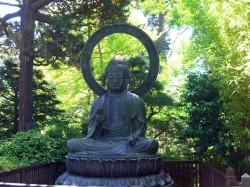People ask me questions about Buddhism and meditation all the time.
So I decided to start a monthly column in order to share some of my answers.
If you would like to submit questions for the next column, please email me at [email protected]
Thanks.
~
An emailer asked:
I heard that Buddhists set fire to themselves during meditation in Vietnam to protest all the warfare. The story says they sat calmly until they burned up. Is this story true? How did they sit still while burning? What’s the deal with this?
I do not recommend this.
This is called self-immolation. It became famous to us in the western world when a Buddhist monk named Thich Quang Duc set himself on fire.
(By the way, Thich is a title, not a name. It’s given to Zen monks in Vietnamese lineages. That’s why Thich Nhat Hanh also has Thich in his name.)
He did this in protest of the persecution of Buddhists that was underway at the time by the South Vietnamese government led by Ngo Dinh Diem. Photographs of Thich Quang Duc’s self-immolation spread around the world and made big news. Thich Quang Duc is not the only monk that did this, but he was the one that brought worldwide attention to the situation
Now, I could try to provide more context, but that is beyond the scope of this column. It will suffice to say that some Buddhist monks have, at times, committed self-immolation as a form of political protest. Suicide as political protest is not a rare thing in history and Buddhists didn’t invent it.
But, it is true that Thich Quang Duc sat calmly in the lotus position, moving mala beads through his fingers and chanting until the fire consumed him and his body fell over.
(There is a video of this even that you can find online.)
I could also post a picture of Thich Quang Duc on fire, but I don’t want to. Above is a photo of a statue instead.
Now, I wasn’t there. I can only speculate. How was he able to sit still after burning himself alive?
Two things were at play here.
One, he was a full time Buddhist monk. More importantly, he had been a full time Buddhist monk since he was seven years old. At the time of his self-immolation he was 66 years old. So, he had been a monk for nearly 59 years. Monk means different things in different lineages. I know monks who don’t meditate at all, who practice Buddhism in different ways. Thich Quang Duc was not one of these. Meditating was like his job and he did it for hours and hours every day.
It’s hard for most of us to imagine, but he had literally spent decades in the lotus posture sitting in meditation. So, he was as prepared as one can be.
The practice he did was chanting. In a meditative chant one tries to simply focus on the chant you’re singing and only experience that and nothing else.
My practice is counting the breath, but chanting works by the same basic meditation theory. You learn, through long term practice, to shut out distractions. If there are cars in the distance, I learn to not attach to the sound and still follow my breath. If my legs hurt a little, I learn to not attach to the pain and to still follow my breath.
We might think of being on fire as more than a mere distraction. But we must remember that he had spent decades training for this. His ability to focus on his chant was probably incredible. I’ve heard it said that you have to practice something for 10,000 hours to be a true expert. He had probably surpassed that several times over.
The other thing at play was his resolve. If he lit himself on fire and ran around screaming it wouldn’t have gotten the same kind of attention. Part of the appeal to the media was that he just sat there calmly. One of the things we train in in Buddhist practice is great resolve.
Just the fact that he decided to set himself on fire proves that he had a lot of determination in this situation.
~
*Disclaimer: Elephant Journal articles represent the personal opinion, view or experience of the authors, and can not reflect Elephant Journal as a whole. This website is not designed to, and should not be construed to, provide medical advice, professional diagnosis, opinion or treatment to you or any other individual, and is not intended as a substitute for medical or professional care and treatment.
Love elephant and want to go steady?
Sign up for our (curated) daily and weekly newsletters!
Editor: Renée Picard
Image: provided by author









Read 2 comments and reply